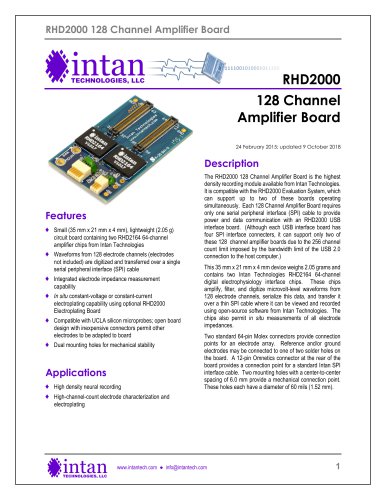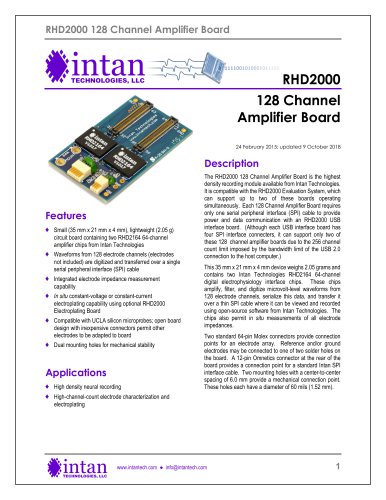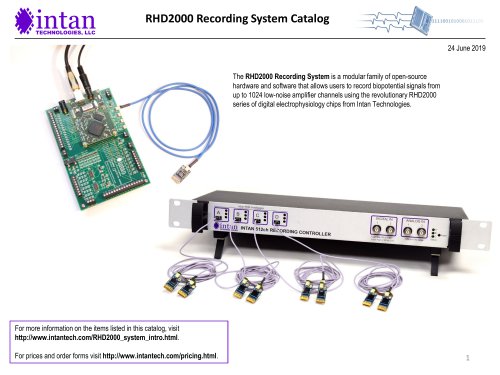 Website:
Intan Technologies
Website:
Intan Technologies
Catalog excerpts

RHD2000 128 Channel Amplifier Board RHD2000 Features ♦ Small (35 mm x 21 mm x 4 mm), lightweight (2.05 g) circuit board containing two RHD2164 64-channel amplifier chips from Intan Technologies ♦ Waveforms from 128 electrode channels (electrodes not included) are digitized and transferred over a single serial peripheral interface (SPI) cable ♦ Integrated electrode impedance measurement capability ♦ In situ constant-voltage or constant-current electroplating capability using optional RHD2000 Electroplating Board ♦ Compatible with UCLA silicon microprobes; open board design with inexpensive connectors permit other electrodes to be adapted to board ♦ Dual mounting holes for mechanical stability Applications ♦ High density neural recording ♦ High-channel-count electrode characterization and electroplating 128 Channel Amplifier Board 24 February 2015; updated 9 October 2018 Description The RHD2000 128 Channel Amplifier Board is the highest density recording module available from Intan Technologies. It is compatible with the RHD2000 Evaluation System, which can support up to two of these boards operating simultaneously. Each 128 Channel Amplifier Board requires only one serial peripheral interface (SPI) cable to provide power and data communication with an RHD2000 USB interface board. (Although each USB interface board has four SPI interface connecters, it can support only two of these 128 channel amplifier boards due to the 256 channel count limit imposed by the bandwidth limit of the USB 2.0 connection to the host computer.) This 35 mm x 21 mm x 4 mm device weighs 2.05 grams and contains two Intan Technologies RHD2164 64-channel digital electrophysiology interface chips. These chips amplify, filter, and digitize microvolt-level waveforms from 128 electrode channels, serialize this data, and transfer it over a thin SPI cable where it can be viewed and recorded using open-source software from Intan Technologies. The chips also permit in situ measurements of all electrode impedances. Two standard 64-pin Molex connectors provide connection points for an electrode array. Reference and/or ground electrodes may be connected to one of two solder holes on the board. A 12-pin Omnetics connector at the rear of the board provides a connection point for a standard Intan SPI interface cable. Two mounting holes with a center-to-center spacing of 6.0 mm provide a mechanical connection point. These holes each have a diameter of 60 mils (1.52 mm). www.intantech.com • info@intantech.com
Open the catalog to page 1
RHD2000 128 Channel Amplifier Board Electroplating Capability Because few commercially-available 128-channel electrode arrays currently exist, this amplifier board was built to support in situ electroplating of electrodes to support users building or customizing their own electrodes. Electroplating is a common electrochemical process used to lower the impedance of microelectrodes by depositing a metal coating onto recording sites from an ionic solution. Common metals used in the electroplating of microelectrodes include gold, platinum, and iridium. A six-pin Omnetics connector near the SPI...
Open the catalog to page 2
IC with CMOS switches for electroplating control 0.06” (1.52 mm) mounting holes (6 mm spacing) The bottom of the 128 Channel Amplifier Board contains a 74HC4053 integrated circuit containing three CMOS switches used for electroplating control. It also contains part R0: a zero-ohm jumper that shorts the reference electrode (REF) to ground (GND). Note that this part must remain in place during electroplating. This jumper may be removed for recordings if an independent reference is desired, but most users of Intan amplifier boards obtain excellent recording quality with this part in place...
Open the catalog to page 3
RHD2000 128 Channel Amplifier Board The photo above shows a 64-channel UCLA silicon microprobe. One of these probes may be connected to either Molex connector on the RHD2000 128 Channel Amplifier Board. The photo above shows a 256 channel UCLA silicon microprobe. Two RHD2000 128 Channel Amplifier Boards may be connected to this probe (one on either side) to fully instrument all 256 recording sites. Circuit Design Serial Peripheral Interface The RHD2000 128 Channel Amplifier Board uses all 12 wires in the SPI interface cable to power and communicate with two RHD2164 chips. The diagram below...
Open the catalog to page 4
RHD2000 128 Channel Amplifier Board Electroplating Control The above diagram shows circuit connections that are relevant for the electroplating capability of the RHD2000 128 Channel Amplifier Board. The VESD pin of each RHD2164 chip is tied to the positive power supply (VDD) which allows the DC input levels at each electrode to range between ground and +3.3 V without activating the on-chip ESD (electrostatic discharge) protection diodes. A 74HC4053 integrated circuit on the bottom of the circuit board contains three CMOS switches that are used for electroplating control. The RHD2000...
Open the catalog to page 5
Related RHD2000 Documentation The following supporting datasheets may be found at http://www.intantech.com/downloads: ♦ RHD2000 Series Digital Electrophysiology Interface Chips Contact Information This datasheet is meant to acquaint engineers and scientists with the RHD2000 128 Channel Amplifier Board developed at Intan Technologies. We value feedback from potential end users. We can discuss your specific needs and suggest a solution tailored to your applications. For more information, contact Intan Technologies. ♦ RHD2164 Digital Electrophysiology Interface Chip ♦ RHD2000 Electroplating...
Open the catalog to page 6




